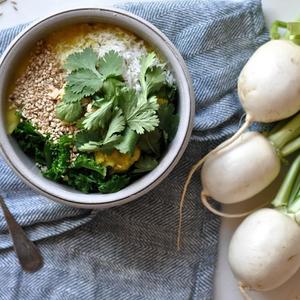Cleansing Kitchari

Kitchari is generally a one pot meal. You may notice that this version uses two pots. It’s just like me to make something as simple as kitchari more complicated. I learned this method of making kitchari, which could aptly be described as soup and rice, from my mom after she returned from doing panchakarma at The Ayurvedic Institute. Panchakarma is an Ayurvedic cleansing program that consists of a diet similar to what I outline here, along with a variety of different treatments, prescribed based on the constitution and imbalances of the individual. The Ayurvedic Institute provided kitchari for her during her stay and it was divided into two pots: the rice in one and a thin mung dal (mung bean soup) in another. When she returned and showed me this method I found that it was really nice to have both super cooked down mung beans and fluffy, not too cooked down rice, something that is hard to achieve in one pot. I also found that this preparation was easier to stomach over multiple days of eating it than the thick porridge like consistency of traditional kitchari. If you decide that you do want to make a one pot kitchari, I have a recipe that you can use here. Just omit all of the fancy toppings and use the garnishes listed in this recipe. The quantities I have listen below should last you for one day of kitchari cleansing, although you may have enough left over for the following day's breakfast. Adapted from Usha and Vasant Lad
